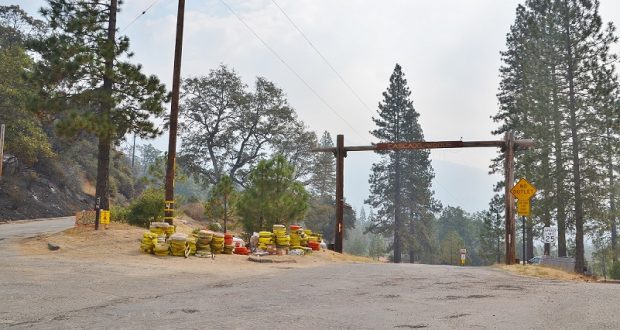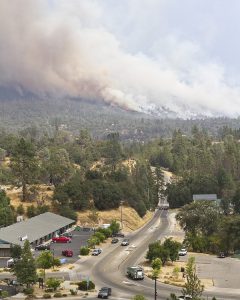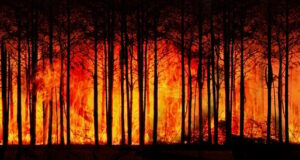NORTH FORK — If you are looking for proof that fuel reduction and preventative activities work, look no further than the community of Cascadel Woods, says Yosemite/Sequoia Resource Conservation and Development Council (Y/S RC&DC) Project Manager Justine Reynolds.
The fast-moving Mission Fire destroyed three homes on its way up the mountain to Cascadel Woods. While credit is always due to the initial attack of our firefighters, it is also well deserved for the folks who worked hard to get the funding to remove dead, receptive fuels from the entrance to the mountain neighborhood.
As one of Madera County’s most at-risk communities, the unique geography of Cascadel Woods makes it a beautiful but potentially dangerous place to call home.
There is only one road out, and though the 8S09 (Whiskey Falls) Road may be a possibility in other circumstances, a section of that road washed out in last winter’s heavy rains. It was also not a viable alternative in this situation, because the fire headed straight up that road.
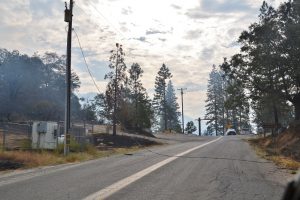 The community applied for grants, and Cal Fire and the Sierra National Forest worked with them for two years to ensure that their access to Road 233 – the only ingress and egress – was clear of dead trees and fuel that could catch fire and block their escape route.
The community applied for grants, and Cal Fire and the Sierra National Forest worked with them for two years to ensure that their access to Road 233 – the only ingress and egress – was clear of dead trees and fuel that could catch fire and block their escape route.
As it turned out, the Mission Fire quickly burned across Road 233 just outside the gate, bringing down power lines and effectively trapping residents for about 90 minutes. But they had a Plan B.
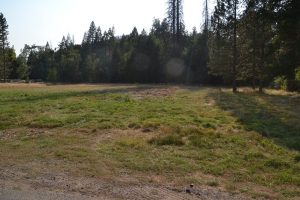 When it became apparent that there was no way out until the power lines were confirmed to be de-energized, nearly 50 people headed to their backup plan — the meadow across from the Clubhouse which has been kept mowed for decades, for just such an eventuality.
When it became apparent that there was no way out until the power lines were confirmed to be de-energized, nearly 50 people headed to their backup plan — the meadow across from the Clubhouse which has been kept mowed for decades, for just such an eventuality.
A fire box containing fire hose was broken open by a resident with a tractor, and others grabbed tools such as pulaskis and shovels, and they moved into the meadow to shelter in place and wait until sheriff’s deputies at scene told them it was safe to head down the hill.
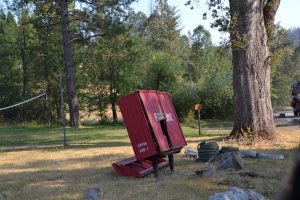 Meanwhile, the fire had raced up from Mission Drive and crested the hill on top of Cascadel Heights. Two homes there were destroyed. On the north side of Road 233, the fire destroyed one home just outside the Cascadel Woods arches.
Meanwhile, the fire had raced up from Mission Drive and crested the hill on top of Cascadel Heights. Two homes there were destroyed. On the north side of Road 233, the fire destroyed one home just outside the Cascadel Woods arches.
Whether it was fire behavior or the hard work of the initial attack firefighters, many residents of Cascadel Woods believe that their preparation to be as fire-safe as possible helped keep their neighborhood from suffering a much worse fate.
In 2015, with the increasing threat of the drought, beetle kill and tree mortality, the residents of Cascadel Woods knew they were vulnerable. As an active Firewise Community, they hosted frequent community chipping days and had an active Fire Brigade, but the 2015 Willow Fire gave the community new resolve.
Between 2015 and 2016 they received approximately $60,000 in grants through Pacific Gas & Electric’s Fuel Reduction program. These funds, administered through local non-profit Yosemite/Sequoia Resource Conservation and Development Council (Y/S RC&DC), improved fuel breaks around the community and removed felled dead trees from homeowner’s properties.
This year the community received $50,000 in federal funding through the CA Fire Safe Council, with the required match provided by the Cal Fire Mt. Bullion crew work days, valued at $30,000. The community received an additional $200,000 from the Cal Fire State Responsibility Area Fire Prevention Fund (SRAFPF – referred to locally as the Rural Fire Fee), administered by another local non-profit, the Foundation for Resource Conservation.
The initial felling and removal, which took place in May and June of this year, focused on exit routes – specifically the area near the arches with heavy tree mortality. Nearly 100 loads of logs were removed through these two sources of funding, with approximately 100 acres treated.
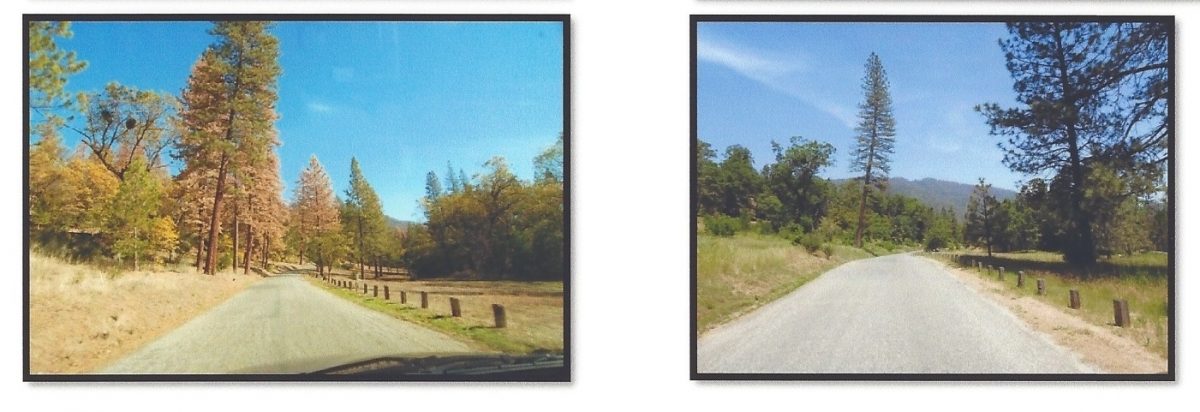
This project work was critical on Sunday, Sept. 3, as the Mission Fire rushed over the ridge. With reduced fuels on the ground, the fire slowed, giving the firefighters time to fight and protect homes in the community, says Justine Reynolds, Project Manager for Y/S RC&DC.
“If these projects had not felled and removed these hazard trees, fire behavior could have become much more intense.”
Additional fuel reduction is planned for the community with over 200 acres left to treat.
“These fuel reduction projects are vital to all our at-risk communities,” says District 5 Supervisor Tom Wheeler, who has assisted in obtaining these grant funds. “Now, with tree mortality on top of our already crowded and unmanaged forest, we have to prioritize fuel reduction projects, and this community was very proactive in doing so.”
Over the last three years, as tree mortality progressed in Eastern Madera County, the Cascadel Woods community has been diligent at reducing their fire risk from tree mortality, says Reynolds, and while also being a recognized Firewise Community and an active Fire Brigade, community leaders have worked with local organizations to implement projects for felling and removal of dead and dying trees.
In 2015, the community received a small grant through Y/S RC&DC from PG&E’s CEMA Fuel Reduction program, in order to do repair work on the fuel breaks around the water tanks and water infrastructure on the eastern edge of the community.
In 2016, the community received another grant, again from PG&E through Y/S RC&DC, primarily for removal of downed trees. This work focused in the north area, around Loma Linda and Vista Drives, and along the main escape route of Cascadel Drive.
In 2017 the community began implementing several grant-funded projects with three different local organizations.
The first grant, managed in partnership with Y/S RC&DC, utilizes federal dollars provided through the California Fire Safe Council’s Grants Clearinghouse Program to fell and remove dead and dying trees, with a significant match from Cal Fire’s Mt. Bullion crews. This project completed on-the-ground work in June 2017, and removed hazard trees from escape route areas near the arch and along Cascadel Drive.
In May, approximately 60 loads of logs were removed and transported to the North Fork Biomass Disposal Facility. Y/S RC&DC has received additional funding from the Cal Fire State Responsibility Area Fire Prevention Fund (SRAFPF or Rural Fire Fee) to implement fuel reduction projects along evacuation routes in Firewise Communities in Eastern Madera County.
Another project, managed in partnership with the Foundation for Resource Conservation, utilizes approximately $200,000 from the Cal Fire SRAFPF for felling and removal on additional parcels with the Cascadel Woods community, to increase the fire safety for the community as a whole, says Reynolds. This project is also funding the purchase of equipment to use for future community projects.
The Coarsegold Resource Conservation District has also received Cal Fire SRAFPF funding, with project goals that include Cascadel Woods.
In addition to tree felling and removal in this community, they are also providing low cost tree felling and removal for disadvantaged homeowners.
Stan Eggink, president of the Cascadel Woods Property Owners Association, says anyone who is not a believer is welcome to come and see for themselves.
“We’ve got to get people to buy into fire prevention,” he says, inviting others to learn from the residents of Cascadel and be convinced.
It should be noted that as of last Friday, the Cascadel Mutual Water Company had provided 417,000 gallons of water to firefighters, not only for the protection of their community, but for all of Cal Fire’s needs.
“There was some difficulty with the water supply on day one when the power went out and the pumps went down,” says Stan. “But we switched over to the spring to fill the tanks, and we had engines and water tenders lined up one after another at the hydrants, and we were happy to do it.

